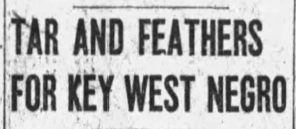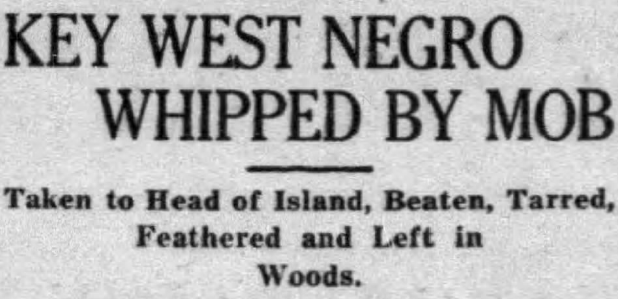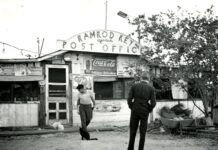The Beatles fought racism from a Key West motel. (You can read about that at keysweekly.com.) You can also fight racism. While we celebrate Key West as “One Human Family,” we must not forget the island’s history of “un-human family” behavior, lest history repeats itself. Love Me Do is a weekly feature that invites readers to learn about the past and reflect on how their own actions and attitudes today might be viewed in the future.
The Key West chapter of the white supremacist hate group, Knights of the Ku Klux Klan, was formed on Feb. 26, 1921. Later that year, Manuel Cabeza was beaten, tarred and feathered by hooded Klansmen for loving a girl with skin that was a different color than his. Two people died in the revenge-driven violence that followed. Still, the Key West Ku Klux Klan continued to engage in tar-and-feathering practices on the island for at least another 13 years.
Tarring and feathering is a method of public humiliation delivered by vigilante groups. Victims in Key West were usually kidnapped, taken to the far side of the island, whipped, stripped naked and painted with hot tar or pitch. The group covered their victim in feathers, then forced them off the island or dumped them on Duval Street as a warning to others who might commit the same infraction. In Key West, newspaper accounts indicate the offense most commonly associated with that particular form of punishment was usually allegedly committed by a black man looking at a white woman “the wrong way.”
Claude Dorsett, a black man in Key West, was arrested for “making improper remarks and gesticulations to women,” and taken to the city jail. Officer Dalziel Albury later tried to transport Dorsett to the county jail for “safety.” A band of 10 men interrupted their journey and removed Dorsett from Albury’s protection at gunpoint. A local newspaper reported, “Although Dorsett cannot be located, the officials are not fearful that great harm has befallen him. There are several reports in circulation, one being that Dorsett was whipped and told to leave town: the other that pools of blood were found near the old Martello tower, and nearby were feathers and spots of tar.”
In May 1926, a Key West “lunacy commission” evaluated a black man for “making an insulting remark to a white woman.” The Nashville Banner reported he was tarred, feathered and told to hit the railroad tracks out of town. The paper also said that this was Key West’s third kidnapping of a black man in two weeks following “alleged insults to white women.”
W. Shanon, a black man, was taken into custody at the Key West jail for “annoying a white woman” on May 2, 1926. The following night at 9:15 p.m., 15 heavily armed men wearing masks entered the jail. They demanded a key to Shanon’s cell from city jailer J.O Kemp. Kemp consented to their demands, and the mob forcibly removed Shanon. The next day’s newspaper reported, “A colored man of giant proportions dressed only in a coat of tar and feathers and his BVDs was summarily dumped from an open touring car in front of Monroe Theater last night. The masked mob told him to ‘dig,’ and he didn’t fail to do it.” The reporter noted, “If he is as good a swimmer as he is a runner, he could have been to the mainland long before this time.” Four days later, the newspaper suggested fixing the island’s insect problem by printing, “All other suggestions having been ignored, how would it do to tar and feather the mosquitoes and give them 24 hours to get out of town?” More violence soon followed.
On May 12, 1926, the criminal court arraigned Criss Cooper before Judge J. Vining Harris. Judge Harris told Cooper, “I learn that you are charged with annoying a white woman on the streets of this city. It is a pity that I have to let you go, for all such cases as these should be punished to the very limit of the law. I am going to let you go now, but I warn you to shake the dust off your feet and get out of Key West at the earliest minute possible and never come back again.”
Perhaps Cooper would have moved a little faster had he known that Judge Harris was “Klaliff” — the second officer in charge of the Key West chapter of the Knights of the Ku Klux Klan. A group of white men abducted Cooper after he left the courtroom. They drove him to Stock Island, and delivered a “spanking he would remember all the days of his life,” the newspaper reported. He was then shown the railroad track and “knew mighty well what to do.” Cooper’s fate is uncertain.
Paige and Benn Roof married in Key West in November 1998. According to the June 27, 2015, Keynoter report, the two lived in the Lower Keys between 2005 and 2008. Here they raised Benn’s son, Dylann, who would have been 11 to 14 years old during his time in the Keys.
On June 17, 2015, Dylann Roof attended a bible study at Emanuel African Methodist Episcopal Church in Charleston, South Carolina. During the bible study, Roof gunned down nine black members of the congregation. According to media reports, Roof’s last words before murdering them were, “You rape our women and are taking over our country.”
Prejudice derived from the fear that black men will rape white women has origins in slavery. To blame Dylann Roof’s actions on tar-and-feather articles that ran in a Key West newspaper nearly 100 years ago would be dishonest. To claim that certain Key West citizens’ actions of 100 years ago have not taught prejudice to people living on the island today would be a lie, too. And while we cannot change our history, perhaps we can seek to identify which elements of it were driven by fear and hate — then ask how we can eliminate our own fears and hates, not for ourselves, but for the benefit of people who will live here long after we are gone.





























